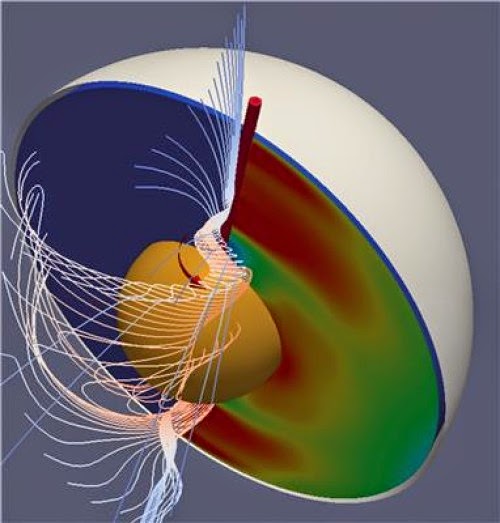
Researchers at the Institut des Sciences de la Terre (CNRS/Université Joseph Fourier Grenoble 1/IRD/Université de Savoie/IFSTTAR) have shown that turbulence, random motion that takes place in the molten metal in Earth’s core, makes a contribution to our planet’s magnetic field. To obtain this result, they modeled Earth’s outer core using liquid sodium enclosed between two rotating concentric metal spheres, a set-up they dubbed the Derviche Tourneur Sodium (DTS) experiment.1
Their findings have just been published in the journal Physical Review Letters.
Like many planets and most stars, Earth produces its own magnetic field by dynamo action, i.e. because of the motion of an electrically conducting fluid-in this case, a mixture of molten iron and nickel. This ocean of liquid metal, the outer core, surrounds the inner core, which is made of solid metal. It is set in motion by the convection caused by the cooling of the core. The resulting flow is particularly complex: in addition to movement of fluid over long distances, which is well understood and generates a magnetic field, there are also turbulent fluctuations, involving erratic, random motion over short distances. Although turbulence also exists in the atmosphere and the oceans, the turbulence in Earth’s core is different, since it is under the combined influence of Earth’s rotation and of a strong magnetic field. It is not currently possible to reproduce this distinctive turbulence either by laboratory experiments or by computer simulations.2 Until now, it was therefore impossible for geophysicists to determine its role with regard to the magnetic field.
In order to better understand the interactions between turbulence and the magnetic field, researchers at the Institut des Sciences de la Terre, in Grenoble, used the Derviche Tourneur Sodium experiment, begun in 2005. In this miniature model of Earth’s core, 40 litres of liquid sodium (an electrically conducting fluid) is enclosed in the space between two concentric spheres. What makes this model unique is that a magnet in the center of the inner sphere provides a strong magnetic field, while the rotation of this core drives the flow of the conducting liquid very effectively. Under these conditions, the liquid sodium is subjected to a strong magnetic field and to fast rotation, as would be expected in Earth’s core, and undergoes both large-scale motion and random fluctuations.
Sensors placed around the outer sphere and inside the sodium were used to map the magnetic field, while ultrasound beams measured the rate of flow of the fluid using the Doppler effect. The data enabled the researchers to show that turbulent motion increases the fluid’s ability to conduct electricity and therefore amplifies the magnetic field, rather than reducing it as earlier experiments had appeared to show. This phenomenon, observed for the first time in the laboratory, was confirmed by numerical simulations.
The findings also apply to planets with a magnetic field and to stars. The discovery of this new component of the magnetic field may explain why in the case of Venus, Earth’s ‘twin’ planet, the liquid metal core does not produce a magnetic field. Closer to home, a better understanding of these turbulent fluctuations could help us to understand magnetic field reversals.
(1) Refers to the members of the Sufi order, the whirling dervishes (‘derviches tourneurs’ in French), who perform a whirling dance.
(2) A complete numerical simulation of the motions taking place in the outer core would make it necessary to cover a wide range of scales with a very small time step, which is out of reach with current capabilities.
Reference:
Simon Cabanes, Nathanaël Schaeffer, Henri-Claude Nataf. Turbulence Reduces Magnetic Diffusivity in a Liquid Sodium Experiment. Physical Review Letters, 2014; 113 (18) DOI: 10.1103/PhysRevLett.113.184501
Note : The above story is based on materials provided by CNRS.










